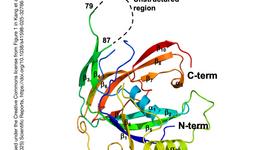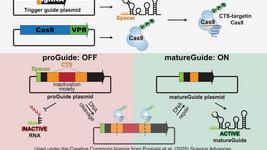Carbon
CARBON Newsletter (29 April 2025) - Your Latest News About CRISPR in AgroBio
By: Gorm Palmgren - Apr. 29, 2025
CRISPR AgroBio News (CARBON) - an emerging initiative from CRISPR Medicine News - has been hibernating for two years, but now we are back on track again.
CARBON will bring you the latest news on how CRISPR can shape agriculture for the future to guarantee food security in times of population growth and climate change.
To get more CRISPR AgroBio News delivered to your inbox, sign up to the free weekly CARBON Newsletter here.
Top picks
- Danish researchers have used CRISPR-Cas9 to knock out key protease inhibitor genes in barley and soybean, enhancing the degradation of storage proteins by reducing the inhibition of digestive enzymes. In both simplex and multiplex edits, CI-1A emerged as the dominant inhibitor in high-inhibition barley. Edited lines showed markedly improved protein digestibility, identifying plant protease inhibitors as strategic targets for boosting nutritional quality in feed and food crops.
- An in planta genome editing system (IPGEC) was developed for citrus, enabling transgene-free, biallelic editing without tissue culture. The system co-delivers Cas9, multiple sgRNAs, regeneration-promoting transcription factors (e.g. WUS, STM, IPT), and T-DNA delivery enhancers via Agrobacterium to soil-grown seedlings. Targeting CsPDS confirmed high-efficiency editing, including in commercial cultivars. This approach accelerates citrus trait improvement while avoiding somaclonal variation.
Technical advances
- Researchers have engineered tobacco rattle virus (TRV) to deliver the compact TnpB enzyme ISYmu1 and guide RNA into Arabidopsis thaliana, enabling transgene-free CRISPR-Cas-like editing in a single step. Edits were stably inherited by the next generation. This virus-based system overcomes delivery bottlenecks, offering a faster, genotype-independent method for plant genome editing.
- CRISPR-Cas9 ribonucleoproteins were used to edit the invertase isozyme II gene in carrot protoplasts, producing transgene-free plants. Editing success reached 17.3% and 6.5% for two sgRNAs, with mutations confirmed via restriction digestion and Sanger sequencing. Three lines were homozygous knockouts. This PEG-mediated RNP delivery method offers a viable route for precision, transgene-free crop improvement.
- French researchers have used CRISPR-dCas9 to target and demethylate the repressive H3K27me3 mark at the Arabidopsis CUC3 gene, triggering ectopic transcription and altered leaf and meristem development. This locus-specific editing confirms H3K27me3’s role in regulating developmental genes and validates CRISPR-based chromatin editing as a precise method to dissect epigenetic contributions to plant morphogenesis.
- Researchers in China have developed the dual-component dual-transcription unit CRISPR-Cas9 system (DDS) architecture that integrates two independent transcription units within a single T-DNA: one expressing Cas9 and the other expressing sgRNAs. Using the pHNR vector to preserve T-DNA integrity and a ~150 bp poly(A) tail to enhance Cas9 expression, the system achieved near-total editing efficiency in tomato. Broader species validation and cost-effective delivery remain key for scale-up.
- CRISPR-Cas9 was used to establish a high-efficiency gene editing platform in Salvia miltiorrhiza, enabling the creation of 1,664 homozygous or biallelic mutants. The inbred line bh2-7 and Agrobacterium strains K599 and C58C1 proved optimal for editing. Target site mismatches and sgRNA structures were key efficiency barriers, informing improved sgRNA design for future medicinal plant engineering.
- A CRISPR-dCas9 toolkit, fused with a stress-responsive membrane-bound NAC domain, enables heat-inducible, reversible gene regulation in solanaceous plants. Upon heat stress, dCas9 relocates to the nucleus, activating or repressing target genes. The system enhanced tomato resistance to bacterial specks and improved heat tolerance by regulating key immunity and stress-related genes, offering precise, stimulus-controlled manipulation of complex traits.
- Under two CRISPR-Cas9 delivery strategies – transgenic and viral – dcl2, dcl3 and dcl4 homozygous mutants were generated in Nicotiana benthamiana, enabling dissection of overlapping RNA silencing pathways. Small RNA profiling revealed distinct impacts of each mutation, though some alleles retained residual function. These validated mutants offer a platform for exploring DCL-mediated regulation in development, stress responses and potential gene-silencing technologies.
- Heritable genome editing in tomatoes was achieved using a TRV-based virus-induced genome editing (VIGE) system delivering mobile RNA-fused gRNAs to SpCas9-expressing lines. Editing efficiency varied with promoter choice, with SlYAO-driven SpCas9 enabling heritable mutations. Optimised conditions, including reduced light, raised heritable editing rates up to 100%. This tissue culture-free method enables efficient, inheritable edits in tomatoes via VIGE once Cas9 lines are established.
Disease and stress control
- Using CRISPR-Cas editing, researchers have knocked out NtSPS1 in tobacco, altering terpenoid profiles and impacting TMV resistance. Widely targeted metabolomics revealed major shifts, notably a fourfold drop in solanesol. Network pharmacology and docking highlighted five terpenoids, with compound 36 showing promising anti-TMV activity. This study offers new insights into engineering tobacco for enhanced viral resistance.
- CRISPR-Cas editing of NAC29 and NAC31 in rice has revealed their crucial role in boosting sheath blight resistance and promoting tillering. These transcription factors interact with BZR1 to activate CAD8B for defence and repress TB1 to enhance tiller number. Their overexpression increased both resistance and yield, providing promising targets for breeding resilient, high-yield rice varieties.
- CRISPR-Cas was used to generate transgene-free sorghum with precise SDN1-induced mutations in CCD7, CCD8, MAX1, and DUF genes, reducing strigolactone exudation and enhancing resistance to Striga. Edited lines showed stable inheritance, phenotypic shifts, and up to 17.5% editing efficiency, offering a promising route to mitigate Striga-related yield losses in Sub-Saharan agriculture.
- CRISPR-Cas9 knockout and overexpression of GmZAT10-1 in soybean revealed its key role in salt stress tolerance via transcriptional activation of GmCLC-c1. Edited lines showed altered ion distribution, improved water status, reduced membrane damage, and better growth under salt stress. GmZAT10-1 regulates Cl⁻ uptake and shoot exclusion, maintaining a favourable Cl⁻/NO₃⁻ ratio crucial for stress adaptation.
- Multiplex CRISPR-Cas12a, using LbCas12a and FnCas12a with six gRNAs and an mRNA-gRNA complex, conferred strong resistance to DNA virus BSCTV and RNA virus TMV in Nicotiana benthamiana. BSCTV loads fell >90%, with reduced symptoms and large viral genome deletions. TMV spread was also suppressed, highlighting Cas12a’s broad antiviral potential and the efficiency of the novel RNA delivery method.
- Deletion of ZFP320 in Plutella xylostella using CRISPR-Cas9 disrupted temperature stress responses, reducing thermal tolerance, survival, and reproductive performance. The gene, upregulated by heat, modulated antioxidant activity via superoxide dismutase and catalase. Knockout mutants showed compromised life-history traits, underscoring ZFP320’s key role in heat adaptation and highlighting ZFPs as targets for pest control under climate stress.
Agronomic traits
- CRISPR-Cas9 knockout of GhRLF1 in cotton delayed defoliant-induced leaf abscission, confirming its role in cytokinin degradation and AZ activation. Overexpression reduced cytokinin and accelerated abscission, while its regulation by GhWRKY70 and GhMYB108 defined a sequential control pathway. A tissue-specific promoter (proPER21::RLF1) enabled rapid, yield-neutral defoliation with reduced defoliant use, advancing sustainable, mechanised cotton harvesting.
- CRISPR-Cas9-edited vrn1 mutants in wheat revealed that VRN1 homoeologs redundantly regulate heading date and plant height. Loss-of-function mutants showed reduced GA3 levels and downregulation of GA biosynthesis genes. VRN1 directly activated TaGA13ox1 and TaGA20ox2 promoters, linking flowering and architecture traits to gibberellin biosynthesis. GA3 application partially rescued mutant phenotypes, highlighting VRN1’s role in modulating growth via GA pathway activation.
- Targeted CRISPR-Cas9 mutagenesis of SSIIa, SSIII and SBEIIb in maise generated novel alleles, with ssIIa and sbeIIb mutants showing significantly higher amylose and resistant starch content. Select lines maintained favourable agronomic traits despite minor yield reductions. The study provides a viable route to breed high-amylose maise with improved nutritional and industrial value, minimising the typical yield-quality trade-off.
Industry
- Cibus’ Sclerotinia-resistant canola traits, developed using the CRISPR-assisted RTDS system without foreign DNA, have been designated as not regulated by USDA-APHIS. This confirms their classification as conventional under U.S. rules, facilitating unrestricted development. The traits offer durable, multi-mode disease resistance and are poised for broader crop application amid growing global regulatory support for precision gene editing.
Detection
- A CRISPR-Cas12a-based diagnostic, coupled with Recombinase-Aided Amplification, was developed to detect the W2027C mutation in herbicide-resistant Leptochloa chinensis. The assay accurately identifies resistance at DNA levels as low as 2 fg/μL, enabling rapid, field-ready differentiation of resistant and susceptible plants. This tool supports real-time resistance monitoring, improving herbicide application decisions and integrated weed management strategies.
Perspectives
- In a perspective in Nature Plants, CRISPR-Cas is forecast to drive plant genome editing towards engineering large structural variations – duplications, deletions, inversions, and translocations – rather than simple mutations. Future strategies aim to mimic natural genome evolution for trait enhancement. Needed advances include programmable recombinases, improved delivery technologies, and non-integrative editing systems to enable rapid, precise crop improvement.
Reviews
- Engineering the fish gut microbiome: could it serve as a future-proof strategy for sustainable aquaculture? This review examines the characteristics and significance of the gut microbiome in aquatic animal health, exploring current and emerging techniques for microbiome engineering, including CRISPR-Cas while addressing associated challenges, limitations, and ethical considerations.
- CRISPR/Cas9 for Heat Stress Tolerance in Rice: A Review. This review highlights the use of CRISPR-Cas9 to investigate gene functions related to heat stress in rice, aiming to advance the development of thermotolerant varieties for improved resilience and food security.
- Harnessing transposable elements for plant functional genomics and genome engineering. This review explores the roles of plant transposable elements in gene regulation, genome evolution, and crop improvement, highlighting their epigenetic control and emerging applications in functional genomics and genome engineering.
- Advances in gene editing-led route for hybrid breeding in crops. This review discusses how RNA-guided nuclease technologies, particularly CRISPR-Cas, revolutionise crop breeding by enabling precise male sterility, haploid induction, synthetic apomixis, and de novo domestication to produce high-yield, transgene-free hybrids for sustainable agriculture.
Tags
CLINICAL TRIALS
IND Enabling
Phase I
Phase II
Phase III
Gastric Cancer and Colorectal Cancer, CRC, (NCT07166263)
Sponsors:
Base Therapeutics (Shanghai) Co., Ltd.
Sponsors:
Base Therapeutics (Shanghai) Co., Ltd.
IND Enabling
Phase I
Phase II
Phase III
Relapsed or Refractory Acute Myeloid Leukemia, AML, (NCT06541444)
Sponsors:
Base Therapeutics (Shanghai) Co., Ltd.
Sponsors:
Base Therapeutics (Shanghai) Co., Ltd.
IND Enabling
Phase I
Phase II
Phase III







